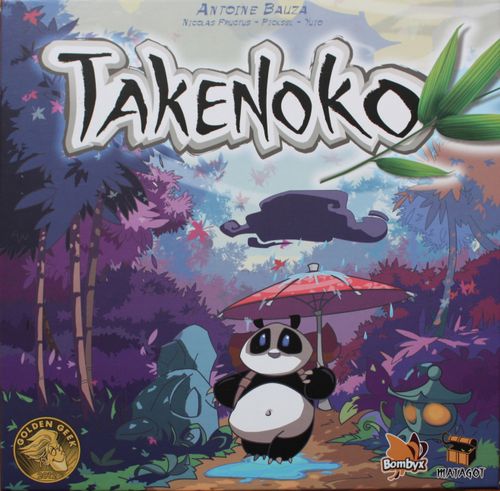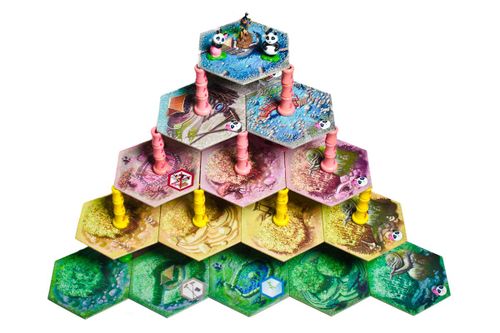
BACKGROUND: Takenoko is a board game published by Bombix for 2 to 4 players.
GAMEPLAY: Each player takes a turn by first rolling the weather die and applying the effect, then selecting 2 different actions to take in any order they wish. Players may build more land and place a new colored tile down, move the farmer or panda figure to grow or eat 1 bamboo if possible, respectively, irrigate the land so bamboo may grow, or draw new objectives.
WEATHER: The die rolled at the beginning has various effects depending on what was rolled. This does not count as any action.
- SUN: The player gains an an additional action that is different to the others.
- RAIN: The player may grow bamboo on any irrigated plot, up to 4 sections tall.
- WIND: The player may choose to take the same action twice, or keep the two seperate actions
- STORM: The lightning scares the panda, allowing the player to move the panda and have him eat a Bamboo section.
- CLOUD: The player gains an improvement to put in their reserve. Improvements cannot be placed on tiles with an improvement on it. Improvements can either prevent the panda from eating in that tile, allow a tile to grow without being irrigated, or double the amount of growth for bamboo.
- QUESTION MARK: The player chooses what weather action to take.

OBJECTIVES: Each card has an objective to complete. Plot objectives require the land tiles to be built and irrigated in specific patterns. The Gardener requires 1 or more bamboo shoots to be grown in a specific color, amount, and with or without certain improvements. The Panda objectives require you to eat specific colors of bamboo and return them to the pool of bamboo The Emperor is given to the first player to hit a required number of objectives, and gives every player one more turn until the end. If at any point an objective is finished, a player may place and score their objective card, regardless of turn order.
WINNING: Once all players have taken their last turn, players discard any objective cards not scored, and total up the points on each objective card scored. The player with the most points wins. In the event of a tie, the player with the most Panda objective cards wins.
CONCLUSION: Takenoko is a deceptively simple game that evolves rapidly into a deep strategy game. It's simple enough on the surface that children can easily grasp the idea and just play, with simple colors and movements. However, it can easily become a cutthroat game of planning and prevention of other scoring with a group of older teens or adults. The fascinating thing with this game is, even with as much strategy as this game has, games will seldom exceeds an hour. This is a great game for dipping your toe into more obscure board games, or even just to play with a group that loves them.

No comments:
Post a Comment